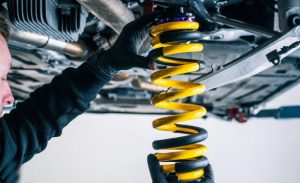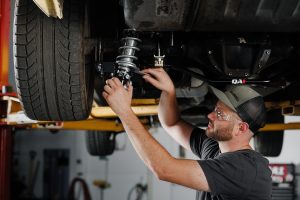Modern suspension systems are carefully engineered to maintain a vehicle’s handling balance, comfort, and safety. At the heart of this system are the springs, which support the vehicle’s weight and absorb road irregularities. However, one common mistake among DIY enthusiasts and even some repair shops is mixing different spring types — for example, installing a progressive-rate spring on one axle and a linear-rate spring on another.
While it might seem like a harmless modification, mixing incompatible springs can lead to severe handling issues, unpredictable ride behavior, and even mechanical failures. Let’s explore why spring compatibility matters, what risks come from mismatched components, and how to make the right choice for your vehicle’s suspension.
The Role of Springs in a Suspension System

Springs are responsible for absorbing shocks from the road surface and maintaining consistent tire contact. They work together with shock absorbers to manage body motion, control roll, and provide comfort.
There are several main types of springs used in modern vehicles:
| Spring Type | Design | Characteristics | Common Use |
|---|---|---|---|
| Coil Springs | Helical-shaped steel wire | Compact, reliable, good comfort | Most passenger cars |
| Leaf Springs | Flat layered steel strips | High load capacity, stiff ride | Trucks, vans, SUVs |
| Torsion Bars | Rods that twist under load | Adjustable ride height | Older or off-road vehicles |
| Air Springs | Rubber bellows filled with air | Adjustable stiffness and height | Luxury cars, commercial vehicles |
| Progressive Springs | Variable coil spacing | Soft initial travel, stiffer under load | Sport-tuned cars, performance setups |
| Linear Springs | Even coil spacing | Consistent stiffness and response | Standard factory suspensions |
Why Compatibility Matters
Your car’s suspension is a balanced system. Springs are matched not only to the vehicle’s weight but also to:
-
The type of shock absorbers used
-
Ride height and corner weight distribution
-
Chassis stiffness and anti-roll bar strength
-
Intended use (comfort, load, or performance)
When one spring type behaves differently from another, the suspension loses symmetry and balance. For example, a softer spring on one axle allows more body roll, while a stiffer one resists it. This imbalance leads to uneven tire grip, poor steering control, and even dangerous instability at high speeds or during braking.
Dangers of Mixing Different Spring Types
Here’s what happens when incompatible springs are installed together:
-
Uneven Handling Behavior
-
One axle may absorb bumps faster, causing inconsistent traction.
-
Vehicle can understeer or oversteer depending on which end is stiffer.
-
-
Increased Body Roll or Pitch
-
Progressive springs on the rear and linear ones on the front, for instance, can cause nose-diving or tail-squatting during braking or acceleration.
-
-
Premature Wear of Suspension Components
-
Shock absorbers, mounts, and bushings are forced to compensate for the imbalance, leading to early failure.
-
-
Incorrect Ride Height
-
Different spring rates alter the car’s stance, affecting alignment and tire wear.
-
-
Safety Hazards
-
In emergency maneuvers, the unpredictable response can cause skidding or rollover risk.
-
Example of Mismatched Setup Results
| Scenario | Spring Combination | Effect on Vehicle | Safety Impact |
|---|---|---|---|
| 1 | Linear front + progressive rear | Rear end too soft under load | Rear instability in curves |
| 2 | Coil spring front + air spring rear | Uneven damping rate | Braking instability |
| 3 | Leaf spring rear + worn coil spring front | Poor balance, nose-dive | Steering loss during braking |
| 4 | Mismatched spring heights | Uneven chassis level | Uneven tire wear and stress on mounts |
How to Ensure Proper Spring Compatibility
To maintain your vehicle’s performance and safety, follow these professional recommendations:
-
Always Replace Springs in Pairs
– Replace both front or both rear springs together to ensure even stiffness and ride height. -
Match Spring Type to Vehicle Specification
– Consult your owner’s manual or OEM catalog to find the exact spring type, rate, and load capacity. -
Avoid Mixing Progressive and Linear Springs
– They react differently to compression forces, leading to unpredictable handling. -
Check Compatibility with Shock Absorbers
– Using high-performance shocks with soft springs (or vice versa) can cause damping imbalance. -
Inspect Mounts, Bushings, and Bearings
– Old or worn mounts reduce spring efficiency and alter suspension geometry. -
Consider Full Suspension Kits
– Many manufacturers offer matched spring-and-shock kits to ensure consistent performance and safe operation.
Example: Correct Matching for Common Vehicle Types
| Vehicle Type | Recommended Spring Type | Ideal Partner Shock Type | Notes |
|---|---|---|---|
| Compact Car | Linear Coil Spring | Twin-tube gas shock | Comfort and stability |
| Sports Coupe | Progressive Coil Spring | Mono-tube gas shock | Better cornering response |
| SUV / Pickup | Leaf or Coil Spring | Heavy-duty gas shock | Load-carrying and off-road |
| Luxury Sedan | Air Spring | Adaptive damper | Comfort and ride height control |
The Cost of Ignoring Compatibility
Mixing spring types can lead to increased operating costs and maintenance over time. The financial implications can be summarized as:
| Issue | Caused By Mismatched Springs | Average Repair Cost (€) |
|---|---|---|
| Premature shock failure | Imbalanced damping | 200–400 per pair |
| Alignment and tire wear | Uneven ride height | 100–250 |
| Suspension mount failure | Excess load stress | 150–300 |
| Handling instability | Incorrect stiffness ratio | Potential accident risk |
In short, saving a few euros on mismatched springs can result in hundreds in repairs — and more importantly, jeopardize your safety.
Professional Tip

When upgrading or replacing suspension parts, always verify part numbers and spring rates. If unsure, consult a suspension specialist or use an online catalog from a trusted source.
To find compatible parts for your specific vehicle model, you can explore high-quality products here:
Buy Springs & Components online
Conclusion
Springs may seem like simple components, but they’re vital for your vehicle’s safety and balance. Mixing different spring types — whether intentionally or by accident — disrupts suspension harmony, causing uneven handling, premature wear, and dangerous instability.
By understanding the importance of compatibility and choosing quality, vehicle-specific springs, you protect both your comfort and your safety. Always replace springs in matched sets and rely on trusted suppliers to ensure every component works perfectly together.
If your vehicle feels unstable or uneven after a suspension repair, it might be time to check whether your springs are properly matched — because in suspension systems, balance is everything.